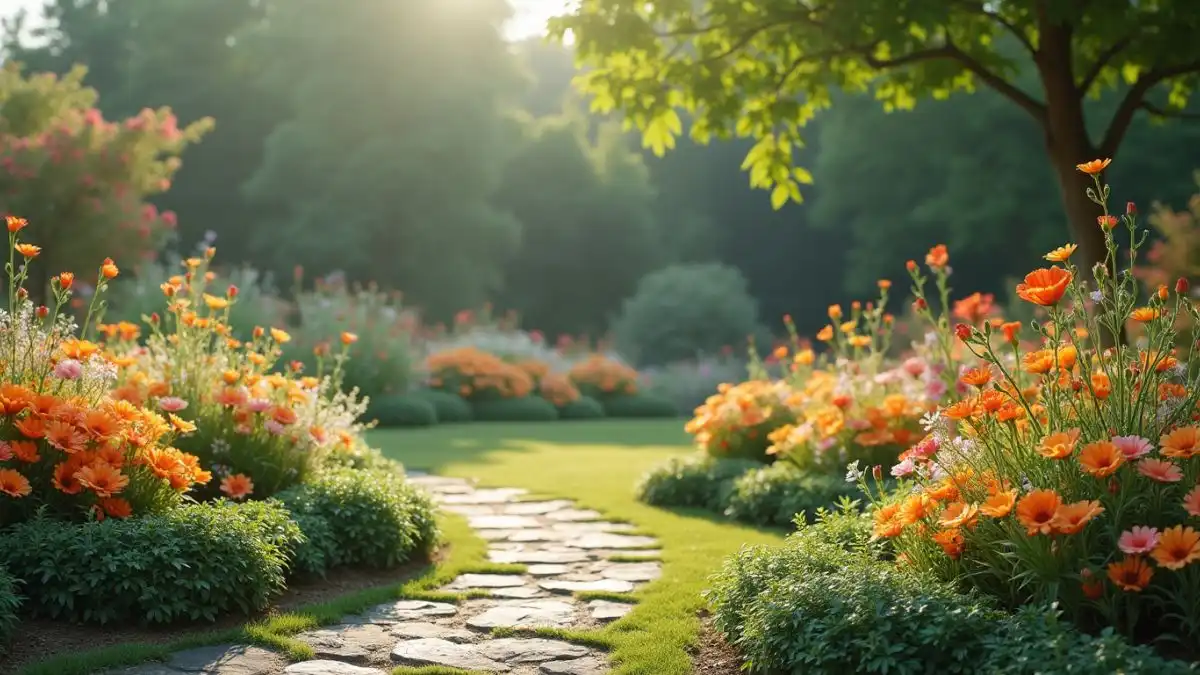Imagine the joy of walking into your garden and being greeted by a vibrant array of blooms, ready to be cut and displayed in your home. Designing a cut flower garden layout is an exciting way to bring beauty, practicality, and creativity into your outdoor space. Whether you’re planning a small flower garden or a large-scale cut garden, these tips and ideas will inspire you to create a layout that fits your needs perfectly.
Table of Contents
Why a Thoughtful Cut Flower Garden Layout Matters
A well-thought-out layout is the foundation of a successful cutting garden. It impacts everything from the health of your plants to how easy it is to harvest your blooms. By focusing on organization and planning, you can:
- Maximize Space: Even a small flower garden can yield abundant blooms with the right layout.
- Enhance Productivity: Organized planting ensures plants grow without overcrowding.
- Simplify Maintenance: Clear pathways and sections make tasks like watering, weeding, and cutting more manageable.
- Boost Aesthetics: A well-planned garden is visually appealing, elevating the overall charm of your outdoor space.
With these benefits in mind, let’s explore how you can create a stunning and productive cut garden.
Key Principles of Designing a Flower Garden for Cutting
Sunlight and Spacing
Flowers thrive in sunlight, and most varieties require 6–8 hours of direct sun daily. Arrange your garden so taller plants don’t shade shorter ones. Proper spacing also allows for air circulation, reducing the risk of diseases.
Soil and Drainage
Nurturing healthy soil is essential for a thriving garden. Opt for well-draining, nutrient-rich loamy soil. If your soil isn’t ideal, raised beds can provide a solution. Enhance the soil by adding organic compost or well-rotted manure.
Accessibility for Harvesting
Paths between rows or sections should be at least 18 inches wide to give you room to move freely while cutting flowers. Accessibility makes the entire gardening process more enjoyable and efficient. Consider installing stepping stones or gravel paths to minimize soil compaction.
Companion Planting
Pair flowers that support each other’s growth. For example, plant marigolds near other blooms to deter pests naturally. Similarly, lavender and rosemary can repel harmful insects while attracting pollinators.
5 Stunning Layout Ideas for Your Cut Flower Garden
1. The Grid Pattern Garden
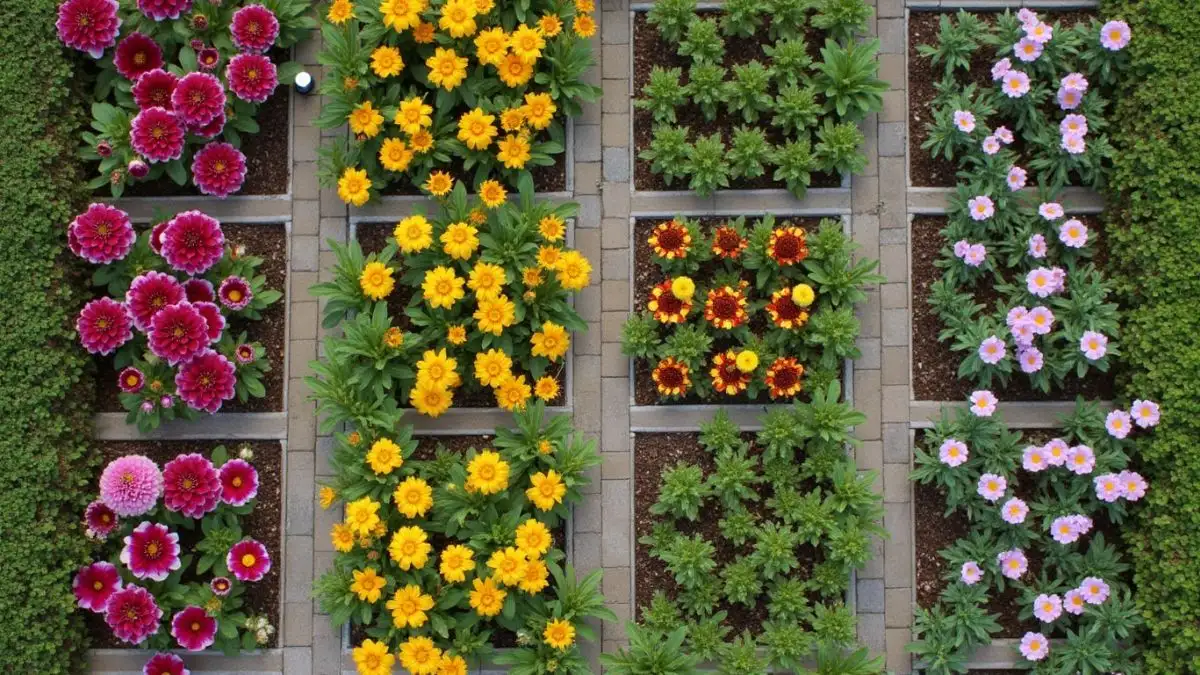
This classic layout divides your garden into evenly spaced rows or squares, making it easy to organize and access plants.
- Ideal for: Beginners or individuals with limited space.
- Flowers to Plant: Dahlias, Zinnias, and Snapdragons.
- Benefits: Clear paths for harvesting and excellent use of space.
Pro Tip: Label each row with the flower variety to stay organized and track growth.
2. The Cottage Garden Look
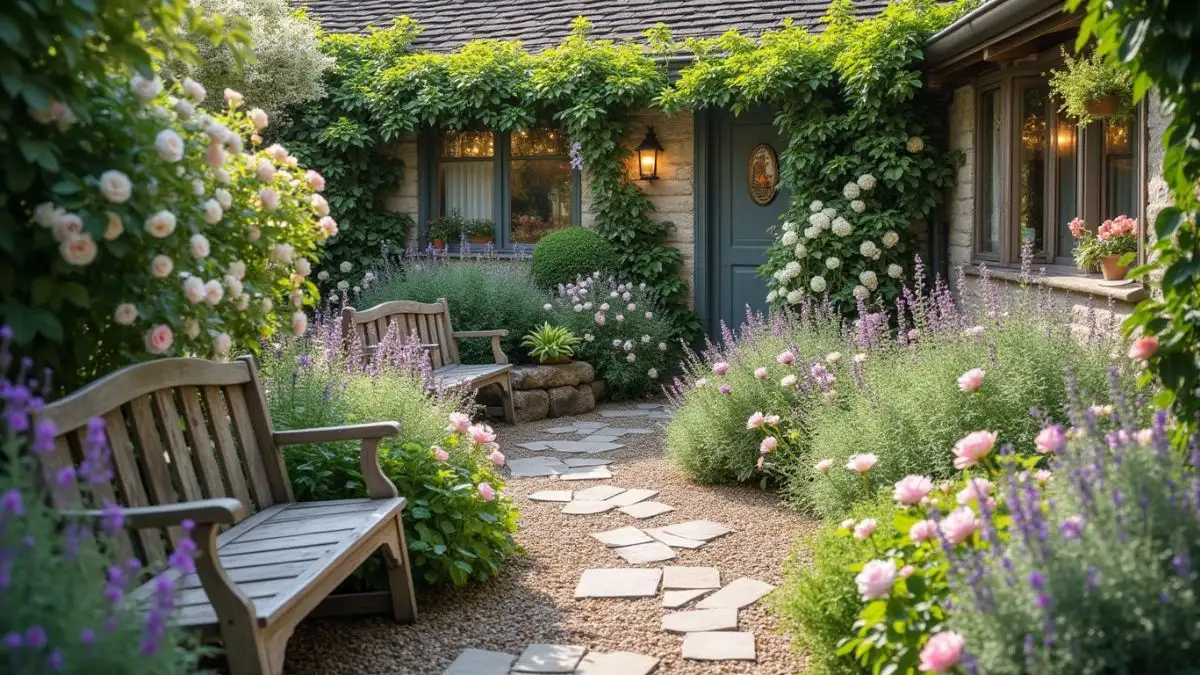
For a whimsical and romantic feel, opt for a cottage-style layout. Blend flowers of various heights, colors, and textures to create a natural look.
- Best For: Those who love a casual, organic aesthetic.
- Flowers to Plant: Roses, Lavender, Delphiniums.
- Tip: Use trellises for climbing plants like sweet peas to add vertical interest.
Example: Combine pastel-colored flowers like pink roses and white peonies for a dreamy, cohesive look.
3. Raised Bed Design
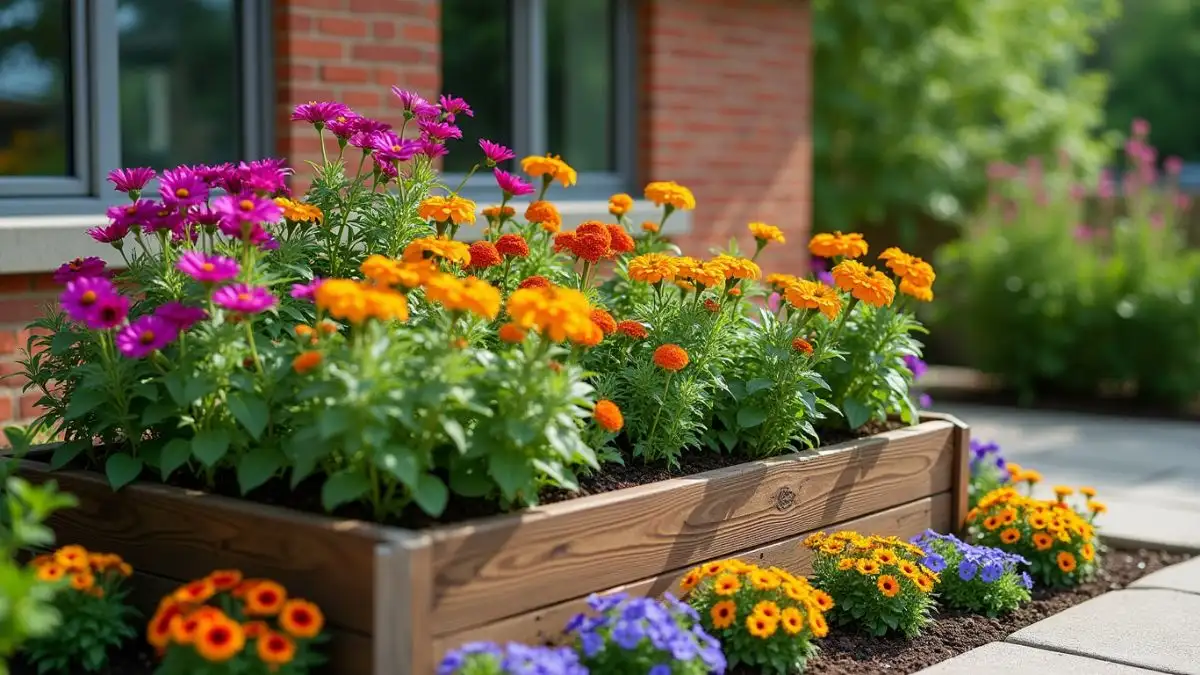
Raised beds are ideal for small flower gardens or areas with poor soil. They provide improved control over soil conditions and drainage.
- Best For: Small spaces and gardeners seeking low-maintenance solutions.
- Flowers to Plant: Cosmos, Marigolds, Sweet Peas.
- Tip: Line the edges with low-growing blooms for a polished look.
Pro Tip: Rotate crops in raised beds annually to prevent soil nutrient depletion.
4. Themed Gardens
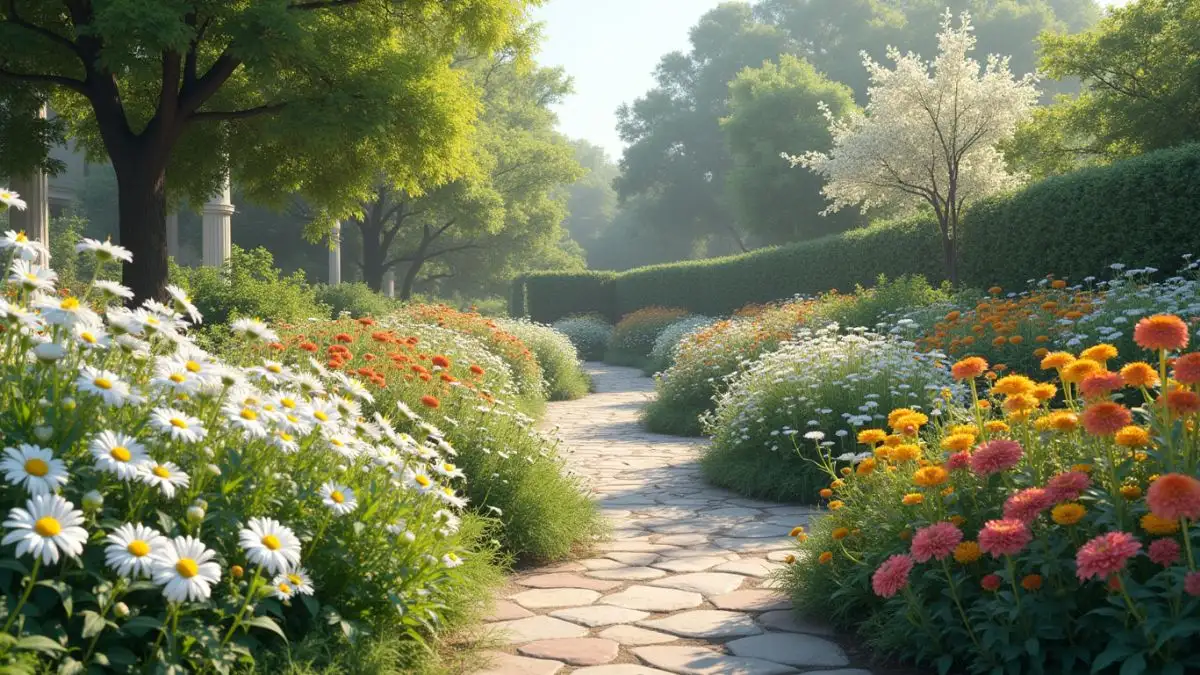
Focus on a specific theme, such as a monochromatic palette or seasonal blooms.
- Best For: Creating cohesive designs that reflect personal style.
- Flowers to Plant: Spring bulbs for a pastel theme, or bright summer blooms for bold colors.
- Examples: An all-white garden with daisies, hydrangeas, and lilies.
Extended Idea: Design a fragrance garden by planting highly aromatic flowers like gardenias, lilacs, and jasmine.
5. Circular or Spiral Layout
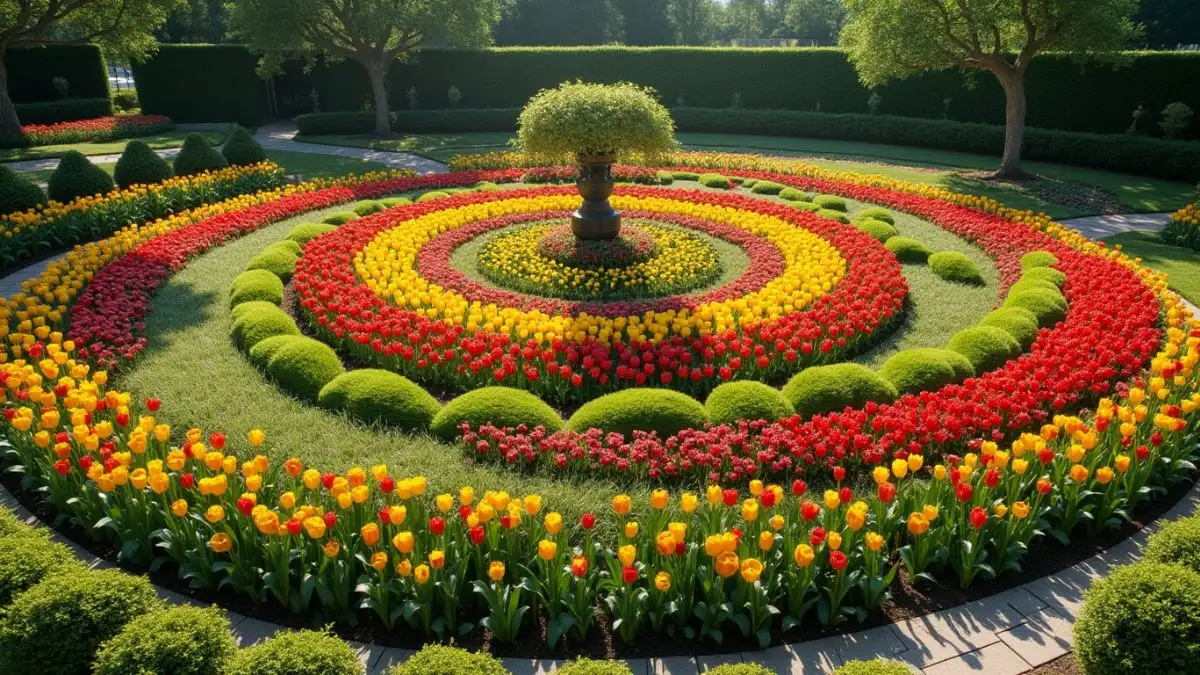
For a striking visual effect, arrange flowers in circular or spiral patterns with a focal point in the center.
- Best For: Large spaces or creating a central garden feature.
- Flowers to Plant: Tulips, Peonies, Sunflowers.
- Tip: Use contrasting colors to enhance the design’s visual impact.
Seasonal Planning for Continuous Blooms
To enjoy a garden that blooms all year, plan for a variety of flowers that peak at different times. This ensures you always have fresh flowers to cut.
Early-Season Flowers
- Crocus, Daffodils, Ranunculus.
- Plant these in fall for early spring blooms.
Mid-Season Flowers
- Dahlias, Snapdragons, Roses.
- Provide consistent watering during their peak growth period.
Late-Season Flowers
- Chrysanthemums, Sunflowers, Asters.
- Extend the life of your cut garden well into autumn.
Tip: Create a bloom calendar to track flowering periods and ensure continuous harvests.
Year-Round Greenery
Don’t forget to include greenery like ferns or eucalyptus to complement your blooms. These plants add texture to bouquets and thrive throughout the year.
Essential Tools and Materials for Your Cut Garden
Tools
- Sharp shears: For clean, precise cuts.
- Garden gloves: Safeguard your hands from thorns and soil.
- Trowels: Ideal for planting and soil work.
- Irrigation system: Ensures consistent watering.
Materials
- Mulch: Retains soil moisture and suppresses weeds.
- Organic fertilizers: Promote healthy growth and vibrant blooms.
- Stakes and supports: Prevent tall plants from toppling over.
Table: Recommended Tools and Their Uses
| Tool | Purpose |
| Sharp Shears | Cutting flowers cleanly |
| Garden Fork | Aerating compact soil |
| Raised Beds | Optimal soil conditions |
| Irrigation System | Consistent watering |
Tips for Harvesting and Arranging Cut Flowers
Harvesting
- Timing: Cut flowers early in the morning when they’re most hydrated.
- Technique: Use sharp shears to avoid crushing stems.
- Conditioning: After cutting, place the stems in water right away to preserve freshness.
Arranging
- Combine flowers of different heights, colors, and textures for a dynamic look.
- Trim leaves that are submerged in water to prevent bacterial buildup.
- Use floral foam or grids to secure arrangements in place.
Table: Flower Vase Life and Preservation Tips
| Flower Type | Vase Life | Preservation Tip |
| Roses | 7–10 days | Use floral preservative |
| Zinnias | 6–8 days | Change water daily |
| Sunflowers | 5–7 days | Keep in cool temperature |
| Snapdragons | 8–10 days | Trim stems diagonally |
Caring for Your Cut Flower Garden
Daily Maintenance
- Water plants deeply and consistently.
- Deadhead spent blooms to encourage new growth.
- Check for pests regularly and act quickly if any are found.
Seasonal Care
- Apply mulch in the spring to help retain moisture and control weeds.
- Fertilize in summer for peak growth.
- Prune in fall to prepare plants for dormancy.
- Rotate plant varieties annually to maintain soil health.
FAQ Section
1. What is the best cut flower garden layout for beginners?
A grid pattern layout is ideal for beginners as it offers structure and simplicity.
2. How do I ensure continuous blooms?
Design your garden with a variety of early, mid, and late-season flowers to ensure a steady harvest.
3. What flowers are easiest to grow in a cutting garden?
Zinnias, Sunflowers, and Snapdragons are easy to grow and yield abundant blooms.
4. How much space do I need for a cutting garden?
Even a small flower garden of 10×10 feet can provide a variety of blooms.
5. Can I plant vegetables in a cut garden?
Yes, companion planting with vegetables like lettuce or carrots works well.
6. What’s the best way to condition cut flowers?
Use clean tools, place stems in water immediately, and add a floral preservative.
7. How do I protect my flowers from pests?
Use organic insecticides or companion plants like marigolds to deter pests naturally.
8. Can I grow cut flowers in containers?
Absolutely! Compact varieties like Cosmos and Sweet Peas thrive in pots.
9. How do I choose colors for a themed garden?
Select complementary or analogous colors based on your desired aesthetic.
10. What soil type is best for a cutting garden?
Loamy soil that drains well and is enriched with organic matter is ideal.
11. What is the best way to prune flowers for improved growth?
Prune dead or damaged stems regularly to encourage healthier blooms.
12. Can I grow flowers indoors for cutting?
Yes, flowers like African violets and certain dwarf varieties can thrive indoors.
Conclusion
A thoughtfully designed cut flower garden layout is your gateway to a vibrant and rewarding gardening experience. Whether you choose a grid, a cottage garden, or a themed design, these ideas and tips will help you create a space that’s as practical as it is beautiful. Start planning today, and soon you’ll be enjoying a bounty of fresh, stunning blooms all season long.
Ready to start your cutting garden journey? Share your favorite layout ideas or gardening tips in the comments below!


